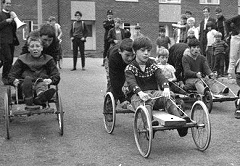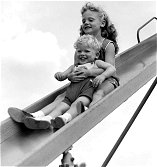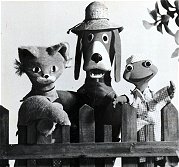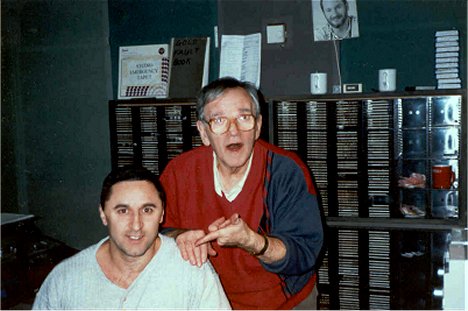


|
 |
|
| A miscellany of memories containing some of the information and stories provided in e-mails from site visitors. Some of the text appears in main articles but a lot of it, although fascinating, is difficult to place on specific pages, therefore I present it here for your interest rather than let it languish in the mailbox! I'm sure some of these will jog interesting memories of your own. Do you have any interesting or unique memories, information, pictures or anecdotes from the Sixties that you would like to share? If you do, contact me at Sixties City - I'd be delighted to hear from you! |
  |
Any
'Sixties' memories or anecdotes are welcome here, on anything you like,
but I'll kick you off with children's playground equipment. Our local
recreation ground (The 'Rec') had 4 types of equipment available: The
Top Hat, The Rocking Horse, The Roundabout and The Swings. All built
into concrete foundations. Soft play area? Health and safety? Hah, we
used to laugh in the face of danger! The only soft landing you were
going to get is if you managed to jump far enough to reach the muddy
grass outside the concrete area.
Or, on the couple of times a year when the council cut the grass, huge stacks of grass piled around the various constructions (when not used to make 'camps') to be jumped into (regardless of any dog poo which, in those days, seemed to be ubiquitous! The council had to pay regular visits to repair our misuse. The Top Hat was regularly dislodged from the top of the centre pole, the Rocking Horse handles used to jam in the top frame and the swings, on metal chains, used to be swung over and over the top bar. The only bit of kit in constant use was the Roundabout but there were so many names carved into the wood that splinters were a common result of exuberant activity. We also used to climb onto the roof of adjacent garages to jump off into the piled grass. Bows and arrows were seasonal, from the nearby willow tree plantings. Arrows were made with metal tips hammered into shape from odd bits and pieces and fitted into slots in the end - but amazingly, nobody ever lost an eye or suffered from being hit by them! There were also go-karts made with old pram wheels! (see top right). |
 |
  |
More from me later.... and from yourselves, to browse through, I have a number of interesting memories, information and anecdotes:See below, and also quite a number of anecdotes from Dermot Elworthy on various aspects of 60s London which can be viewed HERE. |
| Soho - Stuart
Conway From 1961 to 1964 I worked for Reg Knight who owned a photo studio in Soho called "Studio Six" in Old Compton. I remember a beggar who walked around the area with a bath tap stuck on his forehead. The studio was directly opposite the Two I’s coffee bar. We were just across the road on the top floor. I can’t remember the Two I’s owner’s name, even though at the time I knew him quite well. I remember he had slicked back hair which I thought, even back then, was too black to be natural. He would bring us pictures for us to copy and we would make hundreds of prints for him - that was part of my main job. I did a famous picture of “Screaming Lord Sutch" in a chair with very long hair and someone behind him with a big saw about to cut it and Lord Sutch with his mouth open screaming “No”. We also did a picture of Cliff Richard leaning on the Two I’s juke box back when when he had short and very curly hair. Because I knew him, he gave me and my band a gig. At that time every band wanted to play in the Two I’s, so I got to stand and play on that tiny corner stage in the basement where all those famous people had stood before me. My band went down well and the place was packed but we didn’t get 'discovered' …damn it! Next door to us was a coffee bar called the “Act One Scene One” where I used to see Mick Jagger and Keith Richards before they really hit the big time. Further along the road was a great record shop 'Alex Strickland' and that’s where I bought my 45s. |
| At the end of Old Compton Street where it met Charring Cross Road was an outfitter that sold stage clothes for bands. I reckon it was The Stones that put paid to that business because they came on stage in what looked like their every day tatty torn jeans and shirts, and soon after that matching suits and ties and glittery waistcoats were definitely out. I did some recordings at Regent Sound Studio and was amused and amazed that the sound proofing was just a load of old egg boxes glued to the walls and ceilings. I spent all my spare time in Selmers guitar shop, which was my all-time favourite place. My band did gigs at The Whisky, The Flamingo, The Marquee and The 100 club. We even did Ronnie Scott’s, as well as many other places such as The Celebrite,The Kilt, and The El Toro in Finchley Road near Swiss Cottage, so I spent all my days in the Soho studio, and all my nights in the Soho clubs…Ah happy days. Regards Stuart Conway |
 |
Carnaby Street - Tina Palmer Having seen an episode of Michael Portillo's programme featuring Carnaby Street in the Sixties, I saw a clip of the betting office 'Universal Commissions'. Universal Commissions was in fact my father's business - my father Emile Gatta founded it with his close friend Oscar Bucchioni. Oscar owned an Italian restaurant in the mid fifties, called Oscar's, and ran one of the first Italian coffee shops on the premises at 31 Carnaby Street that was to become Universal Commissions. It was a very very busy and well-known coffee shop during the late 50's and all the performers from the Palladium used to frequent it every lunchtime which is where Oscar met his wife as she was one of the original Tiller Girls. My father and Oscar opened the betting office in the rooms above the restaurant in the late fifties, possibly 1957 but the gambling laws changed in 1960 which was when they closed the restaurant and opened it as "Universal Commissions", one of the first betting shops in London. They remained there until the shop was sold to Aristos in 1971. |
|
Alan Freeman - Harvey Staples I thought you might like to have this picture (right) of myself and Fluff at the Capital Radio studios in London circa 1994. I knew Alan from the 70’s when I used to work at the BBC at Portland Place - we were friends for years after that and used to visit him at his flat in Maida Vale. He had a lovely black grand piano and Roman-looking pillars in his flat and he told me that John Lennon and Paul McCartney had played on the piano. He also used to record 'The Roof Garden Interviews' for Radio 1 on the roof of his flat. |
| Chelsea
- Peter Stephens I've just come across your excellent Sixties City website and it has brought back a lot of memories. I can't be 100% accurate about where the establishments were as it was rather a long time ago - but I'll do my best! I lived first in Walpole Street, then Beaufort Street, and then Royal Avenue. I'm not a Londoner and I only lived there from 1959-64 and then on and off until December 1967. On the left hand side going away from Sloane Square there was a boutique called S.W.3 in the Walpole Street/Royal Avenue area. I remember my wife buying a mini-skirt there in the autumn of 1967. Also in the Walpole Street/Royal Avenue area there was a shop called Martin's, which sold records, record players and some other electrical goods. Near the Six Bells public house was the Chelsea Record Centre. On the right hand side going away from Sloane Square there was a Lilley & Skinner between Dolcis and Peter Jones, nearer Peter Jones if I remember correctly. I also had an account at the Midland Bank, which was near Dolcis. Finch's public house was somewhere near Bywater Street. A little further on, in the region of Markham Square, was the Bar-B-Q restaurant. It was fairly basic, plain tables and chairs, crockery and cutlery, but it served large portions of good quality food at reasonable prices. I once saw Dame Sybil Thorndike eating in there. She was said to be a regular customer. I have one story about the Keno Coffee House. I used to meet a friend there on Tuesday afternoons in 1962, and Mandy Rice-Davies and Rachman the slum landlord used to arrive at about the same time. He always parked his blue Rolls-Royce right outside. I don't know how there always came to be a space - perhaps he paid someone. This was before the Profumo scandal broke, so we didn't know who they were then, but suddenly they stopped coming in the November of 1962. When the scandal broke we found out that Rachman had died suddenly in November 1962. |
| World's
End - Kevin Barry I came across your Sixties City site, which I much enjoyed as I grew up in the area through the 50s, 60s and 70s. I lived in Ifield Road as a kid and remember the film crew at Nick's Diner just up the road filming scenes for 'The Servant'. From memory, #502 was Chelsea Scooters - a well-known hangout for the area's mods. There was a massage parlour between Chelsea Scooters and Edith Grove; sorry, can't remember exactly where. Town Records was located in one of these stores at #400 - #404 - a brilliant record shop owned by a guy called Eddie. Between Beaufort Street and Park Walk north side - the Chelsea Kitchen served great food at rock bottom prices. Across the road at #327 or #329 there was a creperie called Asterix for a while. Very trendy. Slightly off your map but perhaps worth a mention - the house at the top of Edith Grove contained a flat owned by Nicolas Saunders who wrote the 70s 'Alternative London' book. The well-known artist, Enzo Plazzotta's studio was in Cathcart Road. My mother worked for him for several years. I have attached fyi one of his etchings World's End 1973 illustrating the erection of the World's End estate (right - click for larger image). |
| King's Road
- Anne Sutherland I just happened to find your web page this afternoon whilst looking up details of a Boutique I worked in during 1967/1968. I applied for a job from an advertisement in The Times newspaper. It read 'Wanted - super secretary for super job with super clothes'. I got the job and started work in the attic as secretary to Mr. Frank Federer and Mr. Henry Keith who owned a clothing manufacturing company based in Bolsover Street called Keith Federer which traded with the Kweens label. On the ground floor of the shop was a retail space and a door to a stock room. The second floor comprised the directors' offices and an empty floor space for modelling the clothes for prospective buyers. All the garments sold in the shop had the Kweens label and were sold to independent boutiques all over the country. There was a garment called 'Pan Pan' which consisted of a very short dress with round neck and cap sleeves. Hundreds of these in different colours were produced and the factory worked flat out. They were very popular. I shared the attic office with an accountantant/book keeper who was constantly trying to keep the books straight as any new boutiques buying goods from us without the correct references had to pay in cash and more often than not Henry would put the money in his shirt top pocket and forget he had it so invoices went out for goods that had already been paid for. I was expected to work long hours - just as I was going home an extra letter or two were found for dictation and when Henry discovered that my train got me to the office half an hour early he quickly utilised it. If he had a client in the showroom and no one else was available I had to find time to model the clothes too! There were two or three assistants in the shop and I believe a Mr. Mendoza was stockroom manager. A Mr. Paul Leader was the Sales Representative. The back window of my office overlooked the Club dell'Aretusa but I only remember seeing Twiggy pushing a lettuce around her plate, and Lionel Bart. |
| King's Road
- Janice Shannon I was fascinated by your map of the Kings Road where I was born and spent my early childhood. My husband worked in a mens boutique called All Kinds at 168 Kings Road, next to Lloyds Bank from 1970-1972. Unfortunately we haven't got a photograph. His father worked at the College of Science and Technology which was situated either side of Manresa Road next to the fire station ie 268-270 Kings Road. All Kinds traded from the late 60s to the mid 70s. It was owned by David Pratt and sold very modern boutique menswear. Many famous customers shopped there including The Four Tops, The Temptations and famous footballers. My husband served Tony Curtis and sold him a jacket. When they released the musical Hair a group of nude women ran down the Kings Road and some came into the shop. The alterations to the clothes sold in the shop were done by Freddie Burretti the famous designer for David Bowie who became a good friend of my husband. He worked in a tailors above one of the shops near Take Six. |
| The
Duke Duval Rockers - Terry Dowker
(Duke Duval Guitarist) The group appeared at The Cavern with Acker Bilk and The John Barry 7 (and other sessions with locally known Merseyside bands) as early as 1958-59 (Acker Bilk) 1960 (The John Barry 7). Duke Duval played as a rock band and not as a skiffle group. As you know this era was the beginning of the transition from Jazz to Rock. The Duke Duval Rockers (or as they were usually known, just Duke Duval) were an integral part of this. The band didn't just appear then - the embryo began in 1954-55 as The Black Denim Boys Skiffle Group. In 1957 the name and the music genre were changed to Duke Duval and Rock respectively. A bit of added interest, when Bob [Wooler] lived in Garston he used to lend us his microphone to help us rehearse, with proviso we would return it the same evening for his MC/DJ work. Recently I came across a list of 10 Cavern facts. Rory Storm and The Hurricanes were entered as the first rock band to appear there, but it looks likely to have been Duke Duval. I hope you engage with my points of interest and enjoy reading them. |
| The Michael Henry
Group - Dave Hi, I have just been looking on your site to see if my old group is listed. (Brilliant site by the way) I was in a group in the 60's, we were a soul band with Colin Areety as our singer, we played all the clubs in Liverpool and supported nearly all the American Soul Artists who came over to Liverpool and performed on the Mardi Gras (Mount Pleasant) and the Victoriana (Victoria Street.). Our band was called "The Michael Henry Group" and are named on the Mathew Street 'Wall of Fame' There is a band in your list called "The Michael Allen Group" and I remember meeting one of the band in the Blue Angel Club about 1968 but they had long since disbanded. Please feel free to contact me if you need anymore info. Dave (Blowes) |
| King's
Road - Angela Harrison-Smith I've just been looking at your website for nostalgic reasons - I used to be a Saturday girl at Just Looking in the early seventies- and thought you may be interested in number 27 Kings Road which you show as "unable to identify". It was a boutique called The Patio - my mother used to work there as an alterationist on the top floor, again in the early seventies. Hope you find this of interest and many thanks for your work in developing this site. It has been a real walk down memory lane. Going to the the Chelsea Drugstore in my lunch hour was the highlight of my week! |
| Cranks
- Jeff Dexter Cranks had Cranks 2 at 10 Ganton Street as well as their first at 22 Carnaby Street, while they were constructing the new building on Marshall Street, plus they had a food Shop at 24 Carnaby Street, a grain store on Newburgh Street, that later moved to 37 Marshall Street too. Hope this is more than useful. Re Dougie Millings: My mentor, later working partner, and house mate, Ian 'Sammy' Samwell was fitted out by him for some time before that, and I got my first suit from there at the tail end of 1961. Dougie had already dressed Cliff Richard, the Shadows and Adam Faith too. Tony Calder, 'Sammy' and I got the Beatles to Dougie's early 62. DJHistory - Jeff Dexter |
|
|
All
Original Material Copyright SixtiesCity
Other individual owner copyrights may apply to Photographic Images |